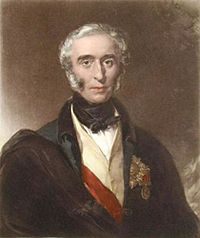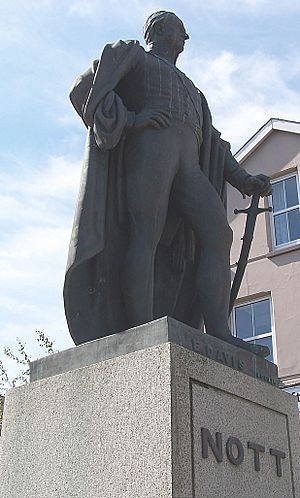William Nott facts for kids
Quick facts for kids
Sir William Nott
GCB
|
|
|---|---|

Sir William Nott by J. Deffet Francis
|
|
| Born | 20 January 1782 Neath, Glamorgan, Wales |
| Died | 1 January 1845 (aged 62) Carmarthen, Wales |
| Allegiance | |
| Service/ |
Bengal Army |
| Years of service | 1798–1843 |
| Rank | Major-General |
| Battles/wars | First Anglo-Afghan War |
| Awards | Knight Grand Cross of the Order of the Bath |

Major-General Sir William Nott was an important British army officer. He worked for the East India Company in British India. He was born on January 20, 1782, and passed away on January 1, 1845.
Contents
Early Life and Joining the Army
William Nott was born in 1782 in Wales, near a town called Neath. His father, Charles Nott, was a farmer. Later, his family moved to Carmarthen, where his father became an innkeeper.
William went to school in Neath and then at Cowbridge Grammar School. He stopped school when his father became an innkeeper. In 1798, when he was 16, William joined a group of volunteers. Two years later, in 1800, he became a cadet in the Indian army. He then traveled to India, which was a big part of the growing British Empire at that time.
Military Career
In 1825, Nott was promoted to lead his regiment, which was a group of soldiers. In 1838, a war called the First Anglo-Afghan War began. Nott was put in charge of a brigade, which is a larger group of soldiers.
From April to October 1839, he was in command of troops in a place called Quetta. He did very well there. In November 1840, he captured Khelat. The next year, he made Akbar Khan and other leaders agree to British rule.
Events in Kabul
In November 1841, Nott heard that the Afghans were fighting back in Kabul. He quickly took action. On December 23, the British envoy, Sir William Hay Macnaghten, was killed in Kabul.
In February 1842, the main British commander, General Elphinstone, ordered that the city of Kandahar should be left. Nott decided not to follow this order. He thought Elphinstone might not be making his own decisions in Kabul.
When Nott heard about the terrible event where many of Elphinstone's soldiers were killed, he told the government in Calcutta to keep soldiers in Kandahar. He wanted to get revenge for the killings.
Victories and Retreat
In March, Nott won a big battle against the enemy near Kandahar. In May, he forced them out of the Baba Wali Pass with heavy losses.
In July, Nott received orders from Lord Ellenborough, who was the Governor-General of India. He was told to leave Afghanistan, but he could go through Kabul. Nott planned to meet up with Sir George Pollock, who was now the commander-in-chief, in Kabul.
On August 30, Nott defeated the Afghans at Ghazni. On September 6, he took control of the fortress there. He also took the gates from the temple of Somnath, as he was told to do by the governor-general. On September 17, he met Pollock in Kabul. The combined armies returned across the Sutlej River in December.
Awards and Retirement
Sir William Nott was highly praised for his service. He was quickly given an important job in Lucknow. He also received a special Sword of Honour. He was made a Knight Grand Cross of the GCB, which is a very high honor.
In 1843, he returned to Britain. The leaders of the British East India Company gave him a pension of £1,000 each year. This would be like getting about £83,000 per year today.
Sir William Nott passed away in Carmarthen on January 1, 1845, when he was 62 years old.
Family Life
William Nott was married two times. His first wife was Letitia Swinhoe. They had five children together. One of their daughters, Charlotte, married John Bower. Their son later became Sir William Nott-Bower.
In 1843, Nott married his second wife, Rosa Wilson Dore. She was much younger than him. After Nott died in 1845, she married Thomas Twisden Hodges. When her second husband passed away in 1865, she went back to using the name Lady Nott.
Statue in Carmarthen
A statue of General Nott was put up in his hometown of Carmarthen in 1851. The artist who made it was Edward Davis. This statue is now considered a Grade II Listed building, which means it is an important historical structure.
The statue was based on a painting of Nott by Thomas Brigstocke, who was also from Carmarthen. The bronze statue was made from cannons that were captured during the Battle of Maharajpur. Queen Victoria herself gave money to help pay for the statue. The statue stands where an old market cross used to be. This area was made into Nott Square in 1846.

